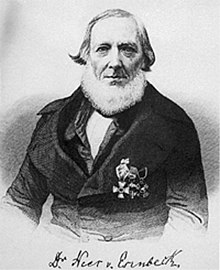
Christian Gottfried Daniel Nees von Esenbeck
Christian Gottfried Daniel Nees von Esenbeck | |
|---|---|
 Christian Gottfried Daniel Nees von Esenbeck in 1855 | |
| Born | Christian Gottfried Daniel Nees von Esenbeck 14 February 1776 Schloss Reichenberg, Reichelsheim (Odenwald), Hesse, Germany |
| Died | 16 March 1858 (aged 82) Breslau |
| Alma mater | University of Jena |
| Scientific career | |
| Fields | Botany, Zoology, Medicine |
Christian Gottfried Daniel Nees von Esenbeck (14 February 1776 – 16 March 1858) was a prolific German botanist, physician, zoologist, and natural philosopher. He was a contemporary of Goethe and was born within the lifetime of Linnaeus. He described approximately 7,000 plant species (almost as many as Linnaeus himself). His last official act as president of the German Academy of Natural Scientists Leopoldina was to admit Charles Darwin as a member. He was the author of numerous monographs on botany and zoology and majority of his best-known works deal with fungi.

Biography
Nees von Esenbeck was born in Schloss Reichenberg near Reichelsheim (Odenwald) in Hesse, Germany. He showed an early interest in science and, after receiving his primary education in Darmstadt, went on to the University of Jena and obtained his degree in biology (natural history) and medicine in 1800. He practiced as a physician for Francis I (Erbach-Erbach), but he had developed a great interest in botany during his university studies which caused him to return to academia.[citation needed] In 1816, he joined the Leopoldina Academy, which was one of the most prestigious institutions in Europe. In 1817, he was appointed professor of botany at the University of Erlangen. Three years later, he became professor of natural history at the University of Bonn, where he established the Botanische Gärten der Friedrich-Wilhelms-Universität Bonn. In 1831, he was appointed as a chair of botany department at the University of Breslau.[1] In 1818, he was elected president of the Leopoldina Academy. He continued as president of the academy for the rest of his life. In botany he achieved notoriety for his contributions to the families Acanthaceae and Lauraceae.[citation needed]

He also became politically active in the German revolutions of 1848–1849. In 1851, due to conflicts with the government, he was deprived of his professorship and pension at Breslau. Seven years later, Nees von Esenbeck died essentially penniless in Breslau. He was an older brother to botanist Theodor Friedrich Ludwig Nees von Esenbeck (1787–1837).[1]

Eponyms
- Wilhelm Kirschstein published Myconeesia in 1936, a genus of fungi in the family Xylariaceae.[3]
- Robert Knud Friedrich Pilger published Neesiochloa in 1940 as a genus of Brazilian plants in the grass family.[4][5][6]
- Margaret Rutherford Bryan Levyns in 1947 published Neesenbeckia, a monotypic genus of flowering plants from South Africa, belonging to the family Cyperaceae.[7]
Works
- Die Algen des süßen Wassers, nach ihren Entwickelungsstufen dargestellt (1814)
- Das System der Pilze und Schwämme (1816)
- Vorlesungen zur Entwickelungsgeschichte des magnetischen Schlafs und Traums (1820)
- Handbuch der Botanik. Band 1 (1820) Digital edition by the University and State Library Düsseldorf
- Handbuch der Botanik. Band 2 (1821) Digital edition by the University and State Library Düsseldorf
- Bryologia germanica (with Christian Friedrich Hornschuch und Jacob Sturm, 1823–31, 2 Bände mit 43 Tafeln)
- Plantarum, in Horto medico Bonnensi nutritarum, Icones selectae (1824) Digital edition by the University and State Library Düsseldorf
- Agrostologia brasiliensis (1829)
- Genera Plantarum Florae Germanicae (1831–1860)
- Genera et species Asterearum (1833)
- Naturgeschichte der europäischen Lebermoose mit Erinnerungen aus dem Riesengebirge (1833-38, 4 Bände)
- Hymenopterorum Ichneumonibus affinium monographiae (1834, 2 Bände)
- System der spekulativen Philosophie, Band 1
- Systema Laurinarum (1836)
- Florae Africae australioris illustration monographicae Gramineae (1841)
- Die Naturphilosophie (1841)
- De Cinnamomo disputatio (1843)
- Synopsis hepaticarum (with Carl Moritz Gottsche und Johann Lindenberg, 1844–1847)
- Die allgemeine Formenlehre der Natur (1852)
References
- ^ a b Chisholm 1911.
- ^ International Plant Names Index. Nees.
- ^ "Myconet". Retrieved 2009-04-21.
- ^ Pilger, Robert Knud Friedrich 1940. Neesiochloa eine neue Gramineengattung aus Brasilien. Repertorium Specierum Novarum Regni Vegetabilis 48: 119–120
- ^ Tropicos, Neesiochloa Pilg.
- ^ Grassbase - The World Online Grass Flora
- ^ "Neesenbeckia Levyns | Plants of the World Online | Kew Science". Plants of the World Online. Retrieved 27 May 2021.
- This article incorporates text from a publication now in the public domain: Chisholm, Hugh, ed. (1911). "Nees von Esenbeck, Christian Gottfried". . Vol. 19 (11th ed.). Cambridge University Press. p. 342.
Further reading
- Jahn: Geschichte der Biologie. Spektrum 2000
- Karl Mägdefrau: Geschichte der Botanik. Fischer 1992
- Bohley, Johanna: Christian Gottfried Daniel Nees von Esenbeck: ein Lebensbild. – Stuttgart: Wissenschaftl. VG, 2003. – ISBN 3-8047-2075-7
- Engelhardt, Dietrich von (Hrsg.): Christian Gottfried Nees von Esenbeck: Politik und Naturwissenschaft in der ersten Hälfte des 19. Jahrhunderts. – Stuttgart: Wissenschaftl. VG, 2004. – ISBN 3-8047-2153-2
External links
- http://www.nees-von-esenbeck.de/ Archived 2019-09-09 at the Wayback Machine (German language site devoted to Nees von Esenbeck; includes extensive biography)
- "History" (in German). Nees-Institut für Biodiversität der Pflanzen. Archived from the original on 2007-06-11. Retrieved 2008-07-24.
- 1776 births
- 1858 deaths
- People from Odenwaldkreis
- German untitled nobility
- German religious humanists
- Members of the Prussian National Assembly
- German taxonomists
- Agrostologists
- German bryologists
- Pteridologists
- German entomologists
- German mycologists
- German phycologists
- 19th-century German botanists
- 19th-century German zoologists
- University of Jena alumni
- Academic staff of the University of Erlangen-Nuremberg
- Academic staff of the University of Bonn
- Academic staff of the University of Breslau
- Presidents of the German National Academy of Sciences Leopoldina
- Taxa named by Christian Gottfried Daniel Nees von Esenbeck
- 18th-century German botanists
See what we do next...
OR
By submitting your email or phone number, you're giving mschf permission to send you email and/or recurring marketing texts. Data rates may apply. Text stop to cancel, help for help.
Success: You're subscribed now !
